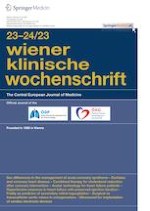30.10.2023 | original article
The relationship of diagonal earlobe crease (Frank’s sign) and obstructive coronary artery disease in patients undergoing coronary angiography
Erschienen in: Wiener klinische Wochenschrift | Ausgabe 23-24/2023
Einloggen, um Zugang zu erhaltenSummary
Background
Traditional risk factors for cardiovascular disease (CVD) play an important role in the clinical evaluation of patients with symptoms suggestive of coronary artery disease (CAD). The utility of the diagonal earlobe crease (DELC) in predicting the presence of CAD is controversial.
Purpose
To investigate the association between DELC, traditional CVD risk factors, and obstructive CAD.
Methods
This prospective study included 1377 patients (mean age 65 ± 10 years, 64% male) who underwent invasive coronary angiography for suspected acute or chronic coronary syndromes. In addition to routine clinical assessment, all patients underwent visual examination of both earlobes for the presence of DELC. All assessments were made by three independent readers, with a majority vote in the case of disagreement. Obstructive CAD was defined by invasive coronary angiography as > 50% stenosis of the left main coronary artery or > 70% stenosis in any other major epicardial coronary artery.
Results
Bilateral DELC was observed more frequently in patients with obstructive CAD than in those without it (67% vs. 33%, p = 0.022). In the multivariate logistic regression model, bilateral DELC was independently associated with CAD (odds ratio [OR] 1.36, 95% confidence interval [CI] 1.07–1.74), along with smoking (OR 1.86, 95% CI 1.44–2.38), diabetes mellitus (OR 1.67, 95% CI 1.29–2.15), male sex (OR 2.04, 95% CI 1.61–2.58), and dyslipidemia (OR 1.54, 95% CI 1.12–2.30); however, the diagnostic accuracy of DELC was modest and resembled that of traditional CVD risk factors.
Conclusion
Despite being independently associated with obstructive CAD, DELC is not a reliable stand-alone clinical marker of CAD due to modest diagnostic accuracy.
Anzeige
